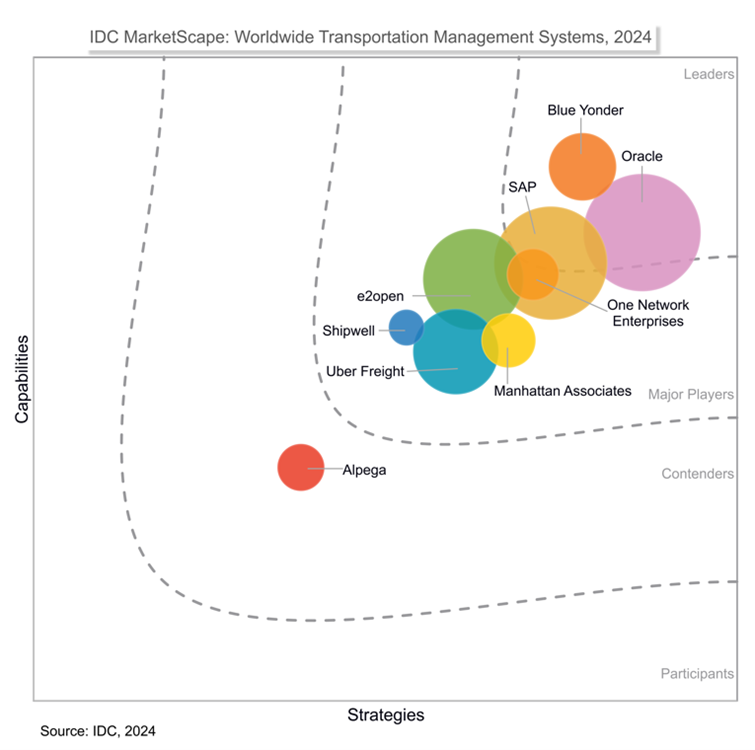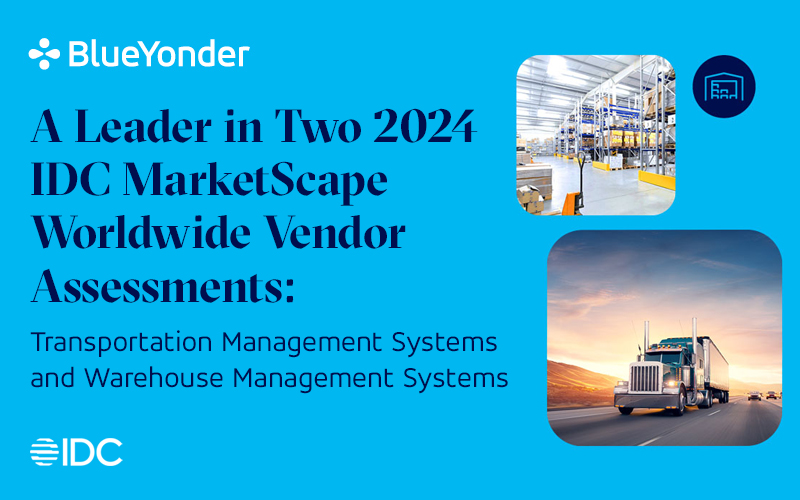Blue Yonder Named a Leader in Both IDC MarketScapes for Worldwide Warehouse Management and Transportation Management Systems Applications
This blog was cowritten by Solutions & Industry Marketing leaders Terence Leung, Clint Reiser, and Jen McQuiston.
Blue Yonder has been named as a Leader in the inaugural IDC MarketScape: Worldwide Warehouse Management (WMS) 2024 Vendor Assessment (doc #US49948523, April 2024) and the inaugural IDC MarketScape: Worldwide Transportation Management Systems (TMS) Applications 2024 Vendor Assessment (IDC #US51982224, April 2024).
Blue Yonder customers’ logistics and supply chain operations across the manufacturing, retail, and logistics service provider (LSP) industries are undergoing significant changes. Most are seeking improved agility and flexibility because of increased supply chain complexity and disruptions. Many are digitally transforming their supply chains into competitive advantages and are investing in artificial intelligence (AI), machine learning (ML), and automation technologies, as well as solutions that can provide end-to-end visibility and can help companies make holistic decisions by synchronizing supply chain execution.
We believe the two IDC MarketScape reports not only confirmed the above trends but explored how solutions are being improved to help customers solve complex logistics problems in this new era. Let us explore the key trends and the innovations that are propelling the customers’ digital journey.
Warehouse Management in the Cloud-Computing Age
Blue Yonder attributes its position as a Leader in the IDC MarketScape Worldwide Warehouse Management 2024 Vendor Assessment to:
- The advanced functionality of its WMS in support of the most complex warehouses and
- The embedded flexibility that allows customers to retain control by easily directing, modifying, and extending the solution to meet their specific and evolving requirements.
As stated by the IDC MarketScape, “The Blue Yonder WMS has embedded functional flexibility and configurability that can be enabled by a warehouse end user. The value is to enable business user control of business logic changes without systemic coding.”
In addition, to enable a progressive journey to cloud computing, Blue Yonder is rapidly increasing its microservices and advancing its AI, generative AI, and ML capabilities. According to the IDC MarketScape for WMS, “Supply chains looking for a set of supply chain applications with microservices that are designed to be augmentative and scalable should consider Blue Yonder.”

Transportation Management as a Key Competitive Advantage
According to the IDC MarketScape, “TMS is evolving to be viewed as a source of potential competitive advantage, whereas it has been traditionally viewed as a support function that relied heavily on manual processes and was supported by antiquated technologies.” To achieve this transformative goal, many customers industrywide are embracing advanced TMS solutions delivered via SaaS.
Blue Yonder has a very similar set of observations in many of its customer deployments. These customers are intending to achieve ambitious and simultaneous goals to become best-in-class in their industries, as well as to improve performance, and increase agility, responsiveness, and sustainability via Blue Yonder’s SaaS-based TMS solution. The broad range of advanced Blue Yonder multi-modal TMS capabilities in transportation planning, optimization, end-to-end execution, and carrier enablement, backed internationally by Blue Yonder and their global partner network, enable customers to achieve these transformation goals.
Our advancements in AI and ML and our comprehensive, end-to-end approach to logistics also are key enablers to automate decision-making and connectivity for customers. These aspects are recognized as key strengths, according to the IDC MarketScape, “Blue Yonder provides a comprehensive suite of products to integrate end-to-end logistics activities. Automated and artificial intelligence–assisted actions provide predictive and prescriptive capabilities across global operations, easing the workload of transportation coordinators and delivering productivity gains.”

Synchronization of Supply Chain Execution
Customers and the industry are also embracing synchronization across supply chain execution. According to the IDC MarketScape, “As organizations prioritize fully integrated supply chains, the ability to synchronize TMS alongside other supply chain applications including OMS, WMS, and YMS helps teams make holistic decisions across operations to evaluate and understand trade-offs across the value chain in real time.”
Blue Yonder enhances the speed and agility of supply chain execution. Blue Yonder provides a real-time, end-to-end solution, powered by the Blue Yonder Platform that enables warehouse, transportation, and order management teams to collaborate from a single set of data and workflows. With expanded interoperable flows and a composable approach, customers have end-to-end visibility and optimization to improve service, profitability, and sustainability.
For years to come, customers will leverage solutions described in the IDC MarketScapes to accelerate improvements in their logistics and supply chain operations. Blue Yonder is committed to its ongoing innovation path in an effort to extend its recognition as a Leader in the IDC MarketScapes for Warehouse Management and Transportation Management Systems Applications.
Source:
IDC MarketScape vendor analysis model is designed to provide an overview of the competitive fitness of ICT suppliers in a given market. The research methodology utilizes a rigorous scoring methodology based on both qualitative and quantitative criteria that results in a single graphical illustration of each vendor’s position within a given market. The Capabilities score measures vendor product, go-to-market and business execution in the short-term. The Strategy score measures alignment of vendor strategies with customer requirements in a 3-5-year timeframe. Vendor market share is represented by the size of the icons.

